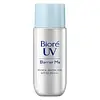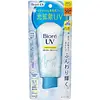What's inside
What's inside
 Key Ingredients
Key Ingredients

 Benefits
Benefits

 Concerns
Concerns

 Ingredients Side-by-side
Ingredients Side-by-side

Cyclopentasiloxane
EmollientZinc Oxide
Cosmetic ColorantHydrogenated Polyisobutene
EmollientTitanium Dioxide
Cosmetic ColorantButylene Glycol
HumectantDimethicone
EmollientNeopentyl Glycol Dicaprate
EmollientC12-15 Alkyl Benzoate
AntimicrobialTalc
AbrasivePEG-30 Dipolyhydroxystearate
EmulsifyingC30-45 Alkyldimethylsilyl Polypropylsilsesquioxane
Water
Skin ConditioningDipropylene Glycol
HumectantSorbitan Isostearate
EmulsifyingPotassium Hydroxide
BufferingGlycerin
HumectantPetrolatum
EmollientButyrospermum Parkii Butter
Skin ConditioningMethicone
EmollientStearic Acid
CleansingDextrin Palmitate
EmulsifyingBis-Vinyldimethicone Crosspolymer
EmollientParfum
MaskingCyclopentasiloxane, Zinc Oxide, Hydrogenated Polyisobutene, Titanium Dioxide, Butylene Glycol, Dimethicone, Neopentyl Glycol Dicaprate, C12-15 Alkyl Benzoate, Talc, PEG-30 Dipolyhydroxystearate, C30-45 Alkyldimethylsilyl Polypropylsilsesquioxane, Water, Dipropylene Glycol, Sorbitan Isostearate, Potassium Hydroxide, Glycerin, Petrolatum, Butyrospermum Parkii Butter, Methicone, Stearic Acid, Dextrin Palmitate, Bis-Vinyldimethicone Crosspolymer, Parfum
Water
Skin ConditioningEthylhexyl Methoxycinnamate
UV AbsorberAlcohol Denat.
AntimicrobialButylene Glycol
HumectantIsopropyl Palmitate
EmollientTitanium Dioxide
Cosmetic ColorantBis-Ethylhexyloxyphenol Methoxyphenyl Triazine
Skin ConditioningEthylhexyl Triazone
UV AbsorberDimethicone
EmollientDimethicone Crosspolymer
Emulsion StabilisingHydrogenated Polyisobutene
EmollientDiethylamino Hydroxybenzoyl Hexyl Benzoate
UV FilterSilica
AbrasiveMica
Cosmetic ColorantDextrin Palmitate
EmulsifyingDipentaerythrityl Tri-Polyhydroxystearate
EmollientAcrylates/C10-30 Alkyl Acrylate Crosspolymer
Emulsion StabilisingTriethoxycaprylylsilane
Cetearyl Alcohol
EmollientGlyceryl Stearate
EmollientHydroxyethylcellulose
Emulsion StabilisingPolysorbate 60
EmulsifyingPolysilicone-9
Potassium Hydroxide
BufferingRoyal Jelly Extract
Skin ConditioningSodium Hyaluronate
HumectantTin Oxide
AbrasivePhenoxyethanol
PreservativeMethylparaben
PreservativeDisodium EDTA
BHT
AntioxidantParfum
MaskingWater, Ethylhexyl Methoxycinnamate, Alcohol Denat., Butylene Glycol, Isopropyl Palmitate, Titanium Dioxide, Bis-Ethylhexyloxyphenol Methoxyphenyl Triazine, Ethylhexyl Triazone, Dimethicone, Dimethicone Crosspolymer, Hydrogenated Polyisobutene, Diethylamino Hydroxybenzoyl Hexyl Benzoate, Silica, Mica, Dextrin Palmitate, Dipentaerythrityl Tri-Polyhydroxystearate, Acrylates/C10-30 Alkyl Acrylate Crosspolymer, Triethoxycaprylylsilane, Cetearyl Alcohol, Glyceryl Stearate, Hydroxyethylcellulose, Polysorbate 60, Polysilicone-9, Potassium Hydroxide, Royal Jelly Extract, Sodium Hyaluronate, Tin Oxide, Phenoxyethanol, Methylparaben, Disodium EDTA, BHT, Parfum
 Reviews
Reviews

Ingredients Explained
These ingredients are found in both products.
Ingredients higher up in an ingredient list are typically present in a larger amount.
Butylene Glycol (or BG) is used within cosmetic products for a few different reasons:
Overall, Butylene Glycol is a safe and well-rounded ingredient that works well with other ingredients.
Though this ingredient works well with most skin types, some people with sensitive skin may experience a reaction such as allergic rashes, closed comedones, or itchiness.
Learn more about Butylene GlycolDextrin Palmitate comes from the palmitic acid ester of Dextrin. It is used as an emulsifier and texture enhancer.
Emulsifiers help keep ingredients together. According to a manufacturer, dextrin palmitate helps create a low-viscosity gel texture.
Due to its fatty acid base, this ingredient is not fungal-acne safe.
Learn more about Dextrin PalmitateDimethicone is a type of synthetic silicone created from natural materials such as quartz.
What it does:
Dimethicone comes in different viscosities:
Depending on the viscosity, dimethicone has different properties.
Ingredients lists don't always show which type is used, so we recommend reaching out to the brand if you have questions about the viscosity.
This ingredient is unlikely to cause irritation because it does not get absorbed into skin. However, people with silicone allergies should be careful about using this ingredient.
Note: Dimethicone may contribute to pilling. This is because it is not oil or water soluble, so pilling may occur when layered with products. When mixed with heavy oils in a formula, the outcome is also quite greasy.
Learn more about DimethiconeHydrogenated Polyisobutene is a synthetic polymer. Polymers are compounds with high molecular weight. Hydrogenated Polyisobutene is an emollient and texture enhancer.
In one study, Hydrogenated Polyisobutene showed better skin hydration levels than Caprylic/Capric Triglyceride. As an emollient, it helps keep your skin soft and hydrated by trapping moisture in.
Hydrogenated Polyisobutene is often used as a mineral oil replacement.
Learn more about Hydrogenated PolyisobuteneParfum is a catch-all term for an ingredient or more that is used to give a scent to products.
Also called "fragrance", this ingredient can be a blend of hundreds of chemicals or plant oils. This means every product with "fragrance" or "parfum" in the ingredients list is a different mixture.
For instance, Habanolide is a proprietary trade name for a specific aroma chemical. When used as a fragrance ingredient in cosmetics, most aroma chemicals fall under the broad labeling category of “FRAGRANCE” or “PARFUM” according to EU and US regulations.
The term 'parfum' or 'fragrance' is not regulated in many countries. In many cases, it is up to the brand to define this term.
For instance, many brands choose to label themselves as "fragrance-free" because they are not using synthetic fragrances. However, their products may still contain ingredients such as essential oils that are considered a fragrance by INCI standards.
One example is Calendula flower extract. Calendula is an essential oil that still imparts a scent or 'fragrance'.
Depending on the blend, the ingredients in the mixture can cause allergies and sensitivities on the skin. Some ingredients that are known EU allergens include linalool and citronellol.
Parfum can also be used to mask or cover an unpleasant scent.
The bottom line is: not all fragrances/parfum/ingredients are created equally. If you are worried about fragrances, we recommend taking a closer look at an ingredient. And of course, we always recommend speaking with a professional.
Learn more about ParfumPotassium hydroxide is commonly known as caustic potash. It is used to fix the pH of a product or as a cleaning agent in soap. In cleansers, it is used for the saponification of oils.
Sapnification is the process of creating fatty acid metal salts from triglycerides and a strong base. During this process, Potassium Hydroxide is used up and is not present in the final product.
Using high concentrations of Potassium Hydroxide have shown to irritate the skin.
Learn more about Potassium HydroxideTitanium dioxide is a mineral UV filter widely used in sunscreens and cosmetics.
It is one of only two UV filters officially classified as “mineral” by regulatory agencies, the other being zinc oxide.
Titanium dioxide provides broad-spectrum protection mostly in the UVB and UVAII range, with some protection in the UVAI range.
While its UVA protection isn’t as strong as zinc oxide’s, the difference is minor.
A common myth is that mineral UV filters reflect UV light. However, modern research shows titanium dioxide absorbs UV radiation like chemical filters (~95% absorption & 5% reflection).
Thanks to its non-irritating nature, titanium dioxide is suitable for sensitive, acne-prone, or redness-prone skin. It is unlikely to cause "eye sting" like other sunscreen ingredients.
A major drawback of this ingredient is its white cast and thick texture. This is why mineral sunscreens often leave a white cast and are less cosmetically elegant than chemical/hybrid sunscreens.
To improve white cast and spreadability, micronized or nano-sized titanium dioxide is often used.
There are ongoing concerns surrounding nano-titanium oxide's impact on marine ecosystems.
There is no conclusive evidence that any form of titanium oxide (or any other sunscreen ingredients) will cause harm to marine ecosystems or coral reefs. The science is still developing but many consumers are keeping a close eye on this issue.
Please note, many destinations have reef-safety sunscreen rules. For instance, the U.S. Virgin Islands advises all visitors to use non-nano mineral sunscreens.
Nano mineral sunscreens once raised safety concerns about absorption into skin.
Extensive research has shown that they do not penetrate healthy or damaged skin; they remain safely on the surface and the top layer of dead skin (stratum corneum).
You'll likely find titanium dioxide bundled with alumina, silica, or dimethicone. These ingredients help make titanium dioxide highly photostable; this prevents it from interacting with other formula components under UV light.
Learn more about Titanium DioxideWater. It's the most common cosmetic ingredient of all. You'll usually see it at the top of ingredient lists, meaning that it makes up the largest part of the product.
So why is it so popular? Water most often acts as a solvent - this means that it helps dissolve other ingredients into the formulation.
You'll also recognize water as that liquid we all need to stay alive. If you see this, drink a glass of water. Stay hydrated!
Learn more about Water